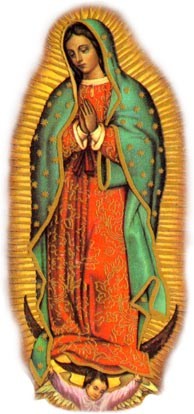| Political
changes in Latin America which ended European control and removed
royal patronage from the Catholic church. |
 |
|
Latin
American independence movements hold "OurLady of Guadalupe"
in high esteem
|
After the American
and the French Revolution, Latin Americans
began to seek their own independence. "Parent" countries were destabilized
by turmoil in Europe and revolutionary ideals began to take hold in Latin
America. Internal tensions about leadership also played a role. From 1810-1816
alone, Venezuela, Paraguay, Mexico, Brazil, and Argentina all declared
independence; the movement continued across the continent. Paths to independence
varied from violent to bloodless revolutions. The revolutionary leader
Simon Bolivar hoped to unite South
America in a confederacy, but his dream was not realized. As independent
countries began to form, the Catholic churches in their midst were no
longer supported by Portugal and Spain, as they had been in the era of
colonial settlement. In the newly independent
nations, old patterns broke up and church and
state conflicts emerged.
|